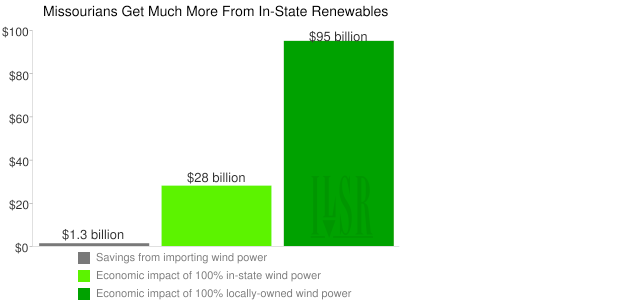Missouri wind farm.Photo: Don HarderThis post originally appeared on Energy Self-Reliant States, a resource of the Institute for Local Self-Reliance’s New Rules Project.
In a stunning reversal of popular wisdom, overzealous state legislators and interest groups are jeopardizing over $4 billion in economic activity and thousands of jobs promised in Missouri’s three-year-old renewable energy law. Missourians should consider the benefits of maximizing the state’s clean electricity production and override their mistaken legislators, reaffirming their commitment to local renewable energy.
In 2008, Missouri voters approved a state renewable energy standard with a two-thirds majority, requiring utilities to get 15 percent of their power from renewable sources within the state or nearby. But in January, the Republican-controlled legislature fired the first salvo against Proposition C, stripping the “buy local” provision from the law and allowing Missouri utilities to acquire renewable energy via accounting measures, rather than constructing wind and solar projects in the state. This summer, the law’s solar rebate program narrowly avoided a legal defeat when the Missouri Retail Association finally gave up its court battle.
Opponents to the renewable energy law have cited high costs, but their actions are heavy with irony: The economic benefits of keeping the “buy local” provision are at least 20 times higher than the savings from importing renewable energy from elsewhere.
The cost for in-state wind power would be less than 5 cents per kilowatt-hour (kWh), including federal tax incentives. Even solar photovoltaics (PV) are affordable. With a 30 percent federal tax credit and the $2 state rebate (recently saved from the legal battle), solar PV can deliver electricity for 9 cents per kWh. For comparison, an average resident of Missouri currently pays around 8 to 9 cents per kWh of electricity.
There are meager savings from importing cheaper wind power instead of building locally. The cheapest wind power in the U.S. would save — at best — about 1.5 cents per kWh, compared to wind power generated in Missouri. Even if it could somehow be delivered to the state with zero transmission cost, meeting the state’s renewable energy goal with remote wind instead of local wind would save ratepayers $200 million.
But these savings are dwarfed by the economic value of in-state renewable energy. A single 2-megawatt wind turbine carries economic benefits of $2 million, according to the American Wind Energy Association. If the state met its renewable standard with in-state wind instead of imports, the economy would gain at least $4.2 billion and over 3,000 jobs.
Even an all-solar program would beat imported wind power by a 4-to-1 ratio. While the cost of solar electricity (and the state rebate program) would be higher — close to $1 billion — relative to imported wind power, meeting the state mandate with solar would balance the cost with an economic gain of $4 billion. And because solar is more labor-intensive, an all-solar 15 percent renewable energy program would also create nearly 80,000 jobs.
The benefits could rise even higher, to $13 or 14 billion, if wind and solar arrays built in Missouri were locally owned. The economic value of locally owned projects is 1.5 to 3.4 times higher than projects locally built but absentee-owned. Maximizing local wind and solar could create 65 times the savings from importing cheap wind power, and an all-wind, all-locally owned approach to the 15 percent standard would double the number of Missouri jobs created.
Given the economic advantages, Missouri voters would do well to pursue 100 percent renewable energy. A 2010 report by the Institute for Local Self-Reliance found that the state could get 21 percent of its power from rooftop solar alone, and has enough high quality wind to power the state three times over. If Missouri met its electricity needs by maximizing rooftop solar and then using high-quality wind power, its economy would get at least a $27 billion boost — 20 times the savings from importing out-of-state wind. Maximizing solar and wind power production in this fashion could also create over 125,000 construction and maintenance jobs in the renewable energy sector.
Outsourcing Missouri’s renewable energy standard might possibly save a few pennies on electricity bills, but it’s penny-wise and pound-foolish, costing the state thousands of jobs and billions in economic activity. Missouri voters should ask for better.



